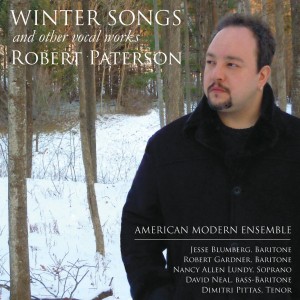Now that we’re well (and sadly?) past the era of composers’ cutting contests, where the likes of Beethoven would take a theme from a pretender and improvise a dazzling set of variations (the origin of the finale of the “Eroica” symphony), it is exceedingly, impossibly rare to witness what I heard in December.
Early in the month, the American Modern Ensemble played a concert at the DiMenna Center for Classical Music. The program was based around music from Robert Paterson’s terrific recent recording, Winter Songs, made with the same ensemble. The concert was bookended by Paterson’s CAPTCHA and the title sequence, about half the contents on the CD (there’s also the song-sets Eating Variations, Thursday and Batter’s Box, making for one of the best releases of 2013).
One of Paterson’s Winter Songs is “The Snow Man,” from Wallace Stevens’ poem. Preceding that set was another song of the same poem, “The Snow Man,” by composer Steven Burke. Two songs from two different composers using the same text, finding entirely different meanings and producing dramatically varied effects. In a strong and enjoyable concert overall, this was a special moment and had a powerful effect.
Paterson is an excellent, old-school style craftsman. He produces limpid melodies and harmonies, his small ensemble orchestrations are colorful and clear, and he values lyricism and beauty. His Winter Songs are just that: despite the overall feeling of shattered loneliness in the poems he collected from Stevens, A.R. Ammons, Richard Wilbur, Robert Creeley, and Billy Collins, the overall feeling is of interpretation at a distance, the composer and listener outside the experience of the poems themselves, safe from the emotional dangers.
Paterson’s “Snow Man” is only shrouded in ice, the warmth from the fire reaches out to touch the music. The singer, bass-baritone David Neal, and the music, describe the emptiness “Of the January sun; and not to think/Of any misery in the sound of the wind,” like a docent describing a painting. Burke’s setting, which came out of a period of personal turmoil for him, is deep inside the music and the poem. His singer was a tenor, John Matthew Myers, and the accompaniment is only violin and piano, not Paterson’s chamber ensemble. The voice of the music is the voice of the snowman, the feeling is of experience, not observation. Burke’s is the sound of a man lying in bed, staring at the ceiling, wondering what the hell he’s going to do.
In contrast to all this is CAPTCHA, the nonsense text used on the web to verify that the user on the other end of the interface is a human being. Paterson collected a decent amount of these … words, such as they are, and made them into songs. They are utterly brilliant, and I’m not sure the composer recognizes their strength. Expertly sung by the great young baritone Jesse Blumberg, they are songs that poke fun at the entire art song tradition and yet fulfill the clichés of the style with skill and wit. That a man can sing “Voix gustroor/voice niionss/MUSICAL alengus/harmonic nstryfl” with a full, beautiful voice and an arched eyebrow, and convey meaning, testifies to how great this set is. By saying nothing, they mean everything. It needs to be a standard choice in the repertoire.
The concert was completed with songs from Tania Léon, Turning, and Russell Platt, “Two Whitman Panels” from his A Walt Whitman Cantata, that varied based on the quality of the poetry. Each composer writes fine vocal music, but Léon’s poetry couldn’t completely fill out her composing. The series of texts, sung by soprano Nancy Allen Lundy, from Sarah White, Lucille Clifton, Janice Mirikitani and Judith Ortiz Carter, hint at both social isolation and rituals that extend from ancient beliefs to modern materialism, but their cores are minimal, and the music tries, not completely successfully, to press them in to a maximal expression. Neither side is wrong, but they mostly mis-fit.
Platt’s two songs, with Jesse Blumberg again, contrast with each other. His settings of the poetry are superb: the first, “When I Heard at the Close of the Day,” is a genteel love song, one man to another, while “I Saw in Louisiana A Live-Oak Growing,” has the pleasing roughness and muscularity that is so special in the poet. Platt captures each quality well.

